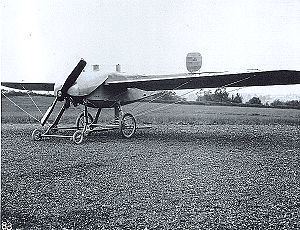Wingspan 11 m First flight 1912 Designer Henri Coandă | Length 8.89 m Manufacturer Bristol Aeroplane Company | |
 | ||
Bristol coanda monoplanes
The Bristol Coanda Monoplanes were a series of monoplane trainers designed by the Romanian designer Henri Coandă for the British company British and Colonial Aeroplane Company.
Contents
- Bristol coanda monoplanes
- Design and development
- Operational history
- Variants
- Operators
- Aircraft on display
- References
Several versions of the plane were built from 1912 onwards with both tandem and side-by-side cockpits. Several were purchased by the War Office for use as trainers by the Royal Flying Corps. International purchases were by Italy and Romania. One example survives in the Gianni Caproni Museum of Aeronautics, Trento, Italy.
Design and development
The Romanian aircraft designer Henri Coandă joined Bristol in January 1912. His first design for Bristol was a two-seat monoplane trainer, a development of the Bristol Prier Monoplane, controlled by wing warping. The first prototype flew in March 1912. A series of similar aircraft followed with both tandem and side-by-side cockpits, known as the School Monoplane and the Side by Side Monoplane.
A more powerful derivative was built for a competition to provide aircraft for the British War Office. Two aircraft, known as Competition Monoplanes were built and entered into the competition, together with two Bristol Gordon England biplanes. The aircraft were flown by Harry Busteed, Bristol's test pilot and James Valentine.
These did well in the competition, rated equal fifth and were described at the time as "well-designed and well-constructed" though criticised as "heavy for the wing area" and lacking in power. This resulted in their being purchased by the War Office for use as trainers by the Royal Flying Corps. These two aircraft formed the basis for a revised military trainer, the Military Monoplane, which had increased wingspan.
The Military Monoplane later formed the basis for the Bristol TB.8, several being rebuilt into TB8s.
Operational history
The first School and Side by Side monoplanes entered service with flying schools operated by Bristol at Larkhill and Brooklands. One tandem and two side-by-side machines were sold to Italy, with four tandem and three side-by-side aircraft being sold to Romania.
The two Competition Monoplanes were bought by the War Office after the Military Aircraft Competition, being used as trainers for the RFC. However, on 10 September 1912, one of the Competition Monoplanes crashed, killing Lieutenants Edward Hotchkiss and Claude Bettington. While this was traced to one of the bracing wires becoming detached, it resulted in a five-month ban of flying of all monoplanes by the military wing of the RFC.
Despite this ban, Military Monoplanes were purchased by Romania and Italy, with a production license being granted to Caproni (although this license was later cancelled, only two being built by Caproni).
Variants
Operators
Aircraft on display
A single Bristol Coanda Monoplane survives, in the Gianni Caproni Museum of Aeronautics, Trento, Italy, being the oldest surviving Bristol aircraft still in existence. This aircraft was a pattern aircraft sent to Caproni as a basis for their licensed production., never being flown, but was restored to a complete example for display at the museum
Data from Bristol Aircraft Since 1910
General characteristics
Performance
Armament
